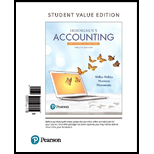
Concept explainers
Accounting for inventory using the perpetual inventory system—FIFO, LIFO, and weighted-average, and comparing FIFO, LIFO, and weighted-average
Learning Objective 2, 3 5. FIFO GP $5,235
Steel Mill began August with 50 units of iron inventory that cost 535 each. During August, the company completed the following inventory transactions:
| Units | Unit Cost | unit Sales Price | ||
| Aug.3 | Sale | 45 | $85 | |
| 8 | Purchase | 90 | $54 | |
| 21 | Sale | 85 | 88 | |
| 30 | purchase | 15 | 58 |
Requirements
1. Prepare a perpetual inventory record for the merchandise inventory using the FIFO inventory costing method.
2. Prepare a perpetual inventory record for the merchandise inventory using the LIFO inventory costing method.
3. Prepare a perpetual inventory record for the merchandise inventory using the weighted-average inventory costing method.
4. Determine the company’s cost of goods sold for August using FIFO, LIFO, and weighted-average inventory costing methods.
5. Compute gross profit for August using FIFO, LIFO, and weighted-average inventory costing method 6. If the business wanted to maximize gross profit, which method would it select?
Want to see the full answer?
Check out a sample textbook solution
Chapter 6 Solutions
Horngren's Accounting, The Financial Chapters, Student Value Edition Plus MyLab Accounting with Pearson eText - Access Card Package (12th Edition)
- 12. Identify the following costs as preveron, appraisal, internal failure, or external failure: a. Inspection of final products b. Sales returns of defective products c. Employee training d. Reworking defective products e. Working with suppliers to ensure delivery of high-quality raw materials f. Costs of warranty repairs g. Product testing Type of cost Prevention Appraisal Internal failure External failurearrow_forwardYou invest $1,500 today to purchase a new machine that is expected to generate the following revenues over the next 4 years: Year 0 1 2 3 4 Cash flow -1500 300 475 680 490 Find the internal rate of return (IRR) from this investment. What would be the net present value (NPV) if the interest rate is 10%? An investment project provides cash inflows of $560 per year for 10 years. What is the project’s payback period if the initial cost is $2,500? What if the initial cost is $3,250? An investment project has annual cash inflows of $2,000, $2,500, $3,000, and $4,000, and a discount rate of 11%. What is the discounted payback period for these cash flows if the initial cost is $4,800? What if the initial cost is $5,600?arrow_forwardHow does the treatment of costs differ in ABC systems as opposed to traditional cost systems?arrow_forward
- Hii ticher please given correct answer general accountingarrow_forwardFinancial accountingarrow_forwardOn October 1, 2019, Ball Company issued 10% bonds dated October 1, 2019, with a face amount of $380,000. The bonds mature in 10 years. Interest is paid semiannually on March 31 and September 30. The proceeds from the bond issuance were $384,776.05 to yield 9.80%. Ball Company has a December 31 fiscal year-end and does not use reversing entries. Required: 1. Prepare journal entries to record the issuance of the bonds and the interest payments for 2019 and 2020 using the effective interest method. 2. Prepare journal entries to record the issuance of the bonds and the interest payments for 2019 and 2020 using the straight-line method.arrow_forward
- Century 21 Accounting Multicolumn JournalAccountingISBN:9781337679503Author:GilbertsonPublisher:Cengage
 Financial And Managerial AccountingAccountingISBN:9781337902663Author:WARREN, Carl S.Publisher:Cengage Learning,
Financial And Managerial AccountingAccountingISBN:9781337902663Author:WARREN, Carl S.Publisher:Cengage Learning,


